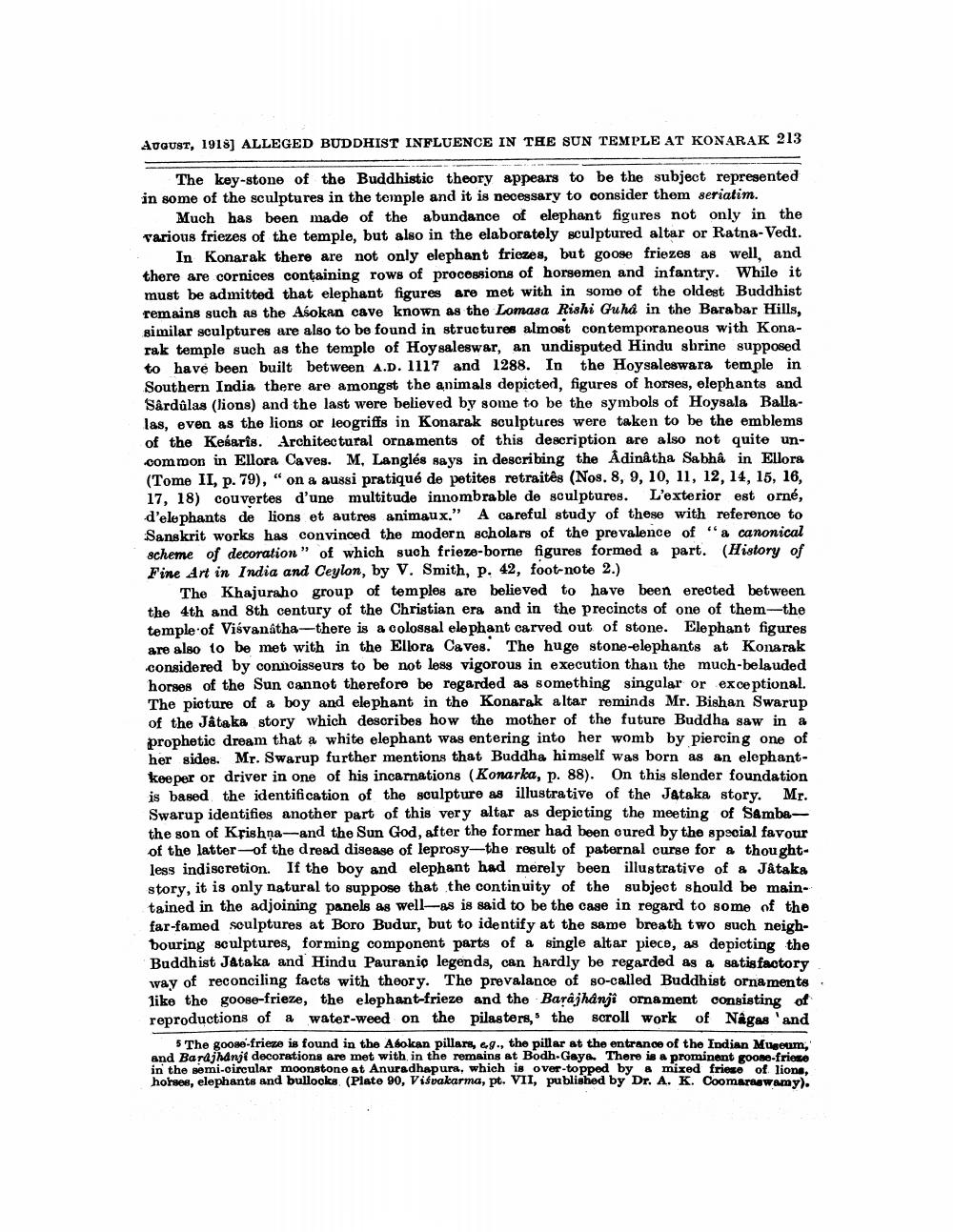________________
AUGUST, 1918) ALLEGED BUDDHIST INFLUENCE IN THE SUN TEMPLE AT KONARAK 213
The key-stone of the Buddhistic theory appears to be the subject represented in some of the sculptures in the temple and it is necessary to consider them seriatim.
Much has boen made of the abundance of elephant figures not only in the various friezes of the temple, but also in the elaborately sculptured altar or Ratna-Vedi.
In Konarak there are not only elephant friozes, but goose friezes as well. and there are cornices containing rows of procossions of horsemen and infantry. While it must be admitted that elephant figures are met with in some of the oldest Buddhist remains such as the Asokan cave known as the Lomasa Rishi Guha in the Barabar Hills, similar sculptures are also to be found in structures almost contemporaneous with Konarak temple such as the templo of Hoy saleswar, an undisputed Hindu sbrine supposed to have been built between A.D. 1117 and 1288. In the Hoysaleswara temple in Southern India there are amongst the animals depicted, figures of horses, elephants and Sârdûlas (lions) and the last were believed by some to be the symbols of Hoysala Ballalas, even as the lions or leogriffs in Konarak sculptures were taken to be the emblems of the Kesaris. Architectural ornaments of this description are also not quite uncommon in Ellora Caves. M, Langlés says in describing the Adinatha Sabhâ in Ellora (Tome II, p. 79), "on a aussi pratiqué de petites retraitês (Nos. 8, 9, 10, 11, 12, 14, 15, 16, 17, 18) couvertes d'une multitude innombrable de sculptures. L'exterior est orné, d'elephants de lions et autres animaux." A careful study of these with reference to Sanskrit works has convinced the modern scholars of the prevalence of "a canonical scheme of decoration" of which such frieze-borne figures formed a part. (History of Fine Art in India and Ceylon, by V. Smith, p. 42, foot-note 2.)
The Khajuraho group of temples are believed to have been erected between the 4th and 8th century of the Christian era and in the precincts of one of them-the temple of Visvanatha--there is a colossal elephant carved out of stone. Elephant figures are also to be met with in the Ellora Caves. The huge stone-elephants at Konarak .considered by connoisseurs to be not less vigorous in execution than the much-belauded horses of the Sun Cannot therefore be regarded as something singular or exceptional. The picture of a boy and elephant in the Konarak altar reminds Mr. Bishan Swarup of the Jâtaka story which describes how the mother of the future Buddha saw in a prophetic dream that a white elephant was entering into her womb by piercing one of her sides. Mr. Swarup further mentions that Buddha himself was born as an elephantkeeper or driver in one of his incarnations (Konarka, p. 88). On this slender foundation is based the identification of the sculpture as illustrative of the Jataka story. Mr. Swarup identifies another part of this very altar as depicting the meeting of Sambathe son of Krishna-and the Sun God, after the former had been cured by the special favour of the latter-of the dread disease of leprosy—the result of paternal curse for a thoughtless indiscretion. If the boy and elephant had merely been illustrative of & Jataka story, it is only natural to suppose that the continuity of the subject should be maintained in the adjoining panels as well as is said to be the case in regard to some of the far-famed soulptures at Boro Budur, but to identify at the same breath two guch neighbouring sculptures, forming component parts of a single alt ar piece, as depicting the Buddhist Jataka and Hindu Pauranio legenda, can hardly be regarded as a satisfactory way of reconciling facts with theory. The prevalance of so-called Buddhist ornaments like the goose-frieze, the elephant-frieze and the Barajhanji ornament consisting of reproductions of a water-weed on the pilasters, the scroll work of Någas 'and
The goon.frieze is found in the Abokan pillars, eg., the pillar at the entrance of the Indian Museum, and Bard jhdnji decorations are met with in the remains at Bodh Gay. There is a prominent goose-friese in the semi-circular moonstone at Anuradhapura, which is over-topped by a mixed frience of lione, horses, elephants and bullooks (Plate 90, Višvakarma, pt. VII, published by Dr. A. K. Coomaraswamy).




